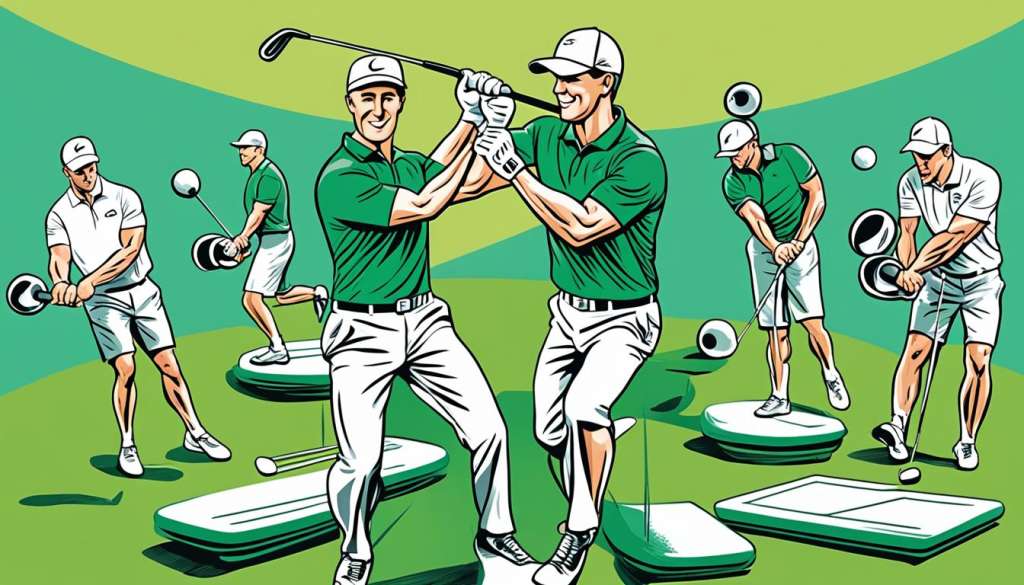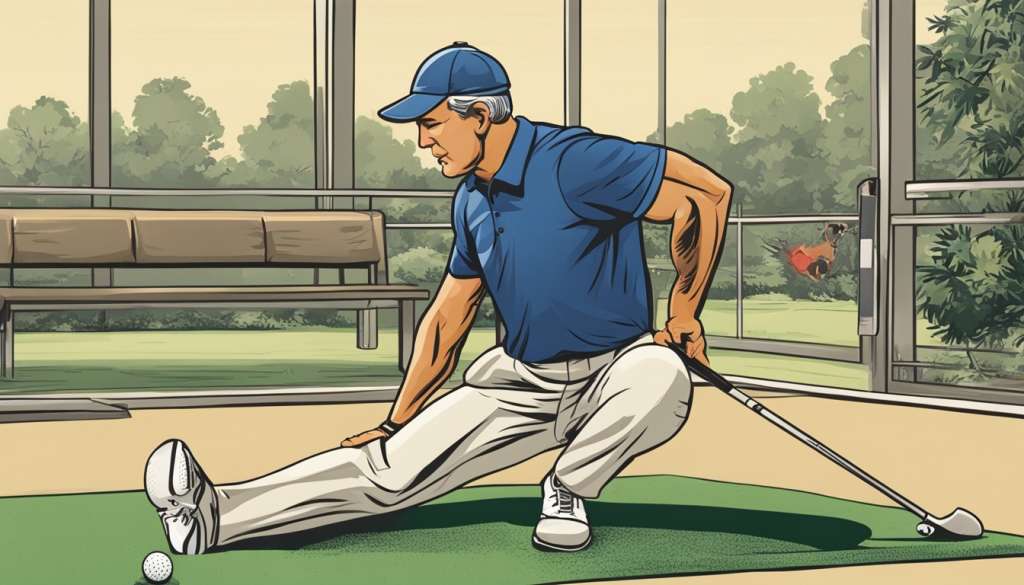Targeted training through golf-specific workouts can boost your game. These routines mix strength, flexibility, and endurance exercises. They improve your swing mechanics, power, and overall performance on the course.
Golf fitness has grown a lot, with stars like Tiger Woods and Greg Norman focusing on strength training. By targeting key muscles and using periodization, you’ll create a full program. This helps prevent fatigue during long games.
Your workout plan should mix on-course practice with off-course training. This method helps you build stamina, power, and flexibility for the whole season. Remember, getting better at golf is not just about technique. It’s also about getting your body ready for the sport’s demands.
Understanding the Importance of Golf-Specific Fitness
Golf fitness has changed a lot over the years. It’s now seen as key to bettering your game and avoiding injuries. Let’s explore how golf fitness has evolved and why it’s vital for golfers.
The evolution of fitness in golf
The journey of golf fitness started in the 1980s. It picked up speed with Tiger Woods’ arrival. His athletic style changed golf forever. Today, pros spend as much time in the gym as on the course, focusing on strength, flexibility, and endurance.
Benefits of targeted training for golfers
Targeted training offers many benefits for golfers. A good fitness plan can better your swing, boost your driving distance, and improve your overall performance. Here are some key benefits:
- Increased power and club head speed
- Improved balance and stability
- Enhanced flexibility and range of motion
- Better core strength for more controlled swings
- Reduced risk of common golf injuries
How fitness impacts performance on the course
Golf-specific fitness has a big impact on performance. A fit golfer keeps proper form over 18 holes, leading to consistent shots. Better endurance means you stay focused and energetic, even in long rounds or tournaments. Here’s how fitness changes your game:
| Fitness Component | Performance Impact |
|---|---|
| Strength | Increased driving distance and power |
| Flexibility | Improved swing mechanics and range of motion |
| Endurance | Better focus and energy throughout the round |
| Balance | Enhanced stability for more accurate shots |
| Core Strength | Improved rotational power and control |
Adding golf-specific fitness to your routine will boost your game in ways you might not expect. It’s time to embrace the athletic side of golf and elevate your performance.
Key Muscle Groups for Golfers to Focus On
To improve your golf game, focus on specific muscle groups. These muscles are key for your swing and overall performance. Let’s look at the main areas to focus on for better golf.
Your core is the heart of your golf swing. It’s vital for staying stable and building rotational power. The muscles in your abdomen, lower back, and obliques work together to make a strong base for your swing.
The hip flexors and gluteal muscles start the downswing and move power from your lower body to your upper body. Strong quads and hamstrings give you the leg strength needed for a steady stance and powerful drive.
Upper body strength is also key. Your latissimus dorsi, or “lats,” help with the backswing and follow-through. Strong shoulder muscles make your swing smoother and more controlled.
- Core muscles: Transverse abdominis, obliques, lower back
- Lower body: Hip flexors, glutes, quads, hamstrings
- Upper body: Lats, shoulders, forearms
By focusing on these key muscle groups, you’ll get the strength and flexibility for a more powerful and consistent golf swing. Don’t forget to work on exercises that boost rotational power. This is key for increasing club head speed and shot distance.
Golf-Specific Workouts Guide: Building Your Routine
Creating a good golf workout routine is essential for better performance on the course. Let’s look at how to make a program that boosts your game and suits your schedule.
Periodization in Golf Training
Periodization is vital for golf workouts. It breaks your training into phases over the year. A typical plan includes:
- Strength and muscle building phase
- Power development phase
- Maintenance phase
Each phase targets different fitness areas, helping you reach your best at key times in the golf season.
Balancing Strength, Flexibility, and Endurance
A good golf workout routine should mix strength, flexibility, and endurance training. This mix boosts your swing power, flexibility, and stamina on the course.
| Component | Benefits | Example Exercises |
|---|---|---|
| Strength | Increased swing power | Squats, deadlifts |
| Flexibility | Improved range of motion | Dynamic stretches, yoga |
| Endurance | Better stamina for 18 holes | Cardio intervals, planks |
Adapting Workouts to Your Playing Schedule
Your golf workout should fit your playing schedule. For most golfers, 2-3 training sessions a week is best. Schedule your workouts around your tee times to keep training balanced and avoid getting tired on the course.
Being consistent in your golf training is crucial. Adjust your workout intensity with your tournament schedule. Focus on maintenance during busy periods and increase training during off-seasons.
Strength Training Exercises for Golf Performance
Golf strength training is key to boosting your game. It helps with swing speed, accuracy, and overall performance. Let’s explore some top exercises for golfers.
Lat pulldowns are vital for upper body strength. They work on the latissimus dorsi muscles, crucial for your swing. Do 3 sets of 10-12 reps, increasing the weight as you get stronger.
Leg presses are great for lower body power. Strong legs support your swing and keep you balanced. Aim for 3 sets of 8-10 reps, focusing on proper form.
Seated rows strengthen your back muscles, bettering your posture and swing. They also help keep your spine stable during the swing. Try 3 sets of 12-15 reps, squeezing your shoulder blades together.
Squats with medicine ball rotations combine lower body strength with rotational power. This exercise mimics the golf swing, building core stability. Do 3 sets of 10-12 reps on each side.
Bent-over rows work on your upper back and biceps. These muscles are key for a strong backswing and follow-through. Aim for 3 sets of 10-12 reps, keeping your back straight.
Include these exercises in your pre-season routine to build functional strength and muscle. As you get better, adjust the weight and reps to keep challenging your muscles and improving your golf game.
Flexibility and Mobility Drills for Improved Swing Mechanics
Improving your golf swing starts with better flexibility and mobility. Adding golf flexibility exercises and mobility drills to your routine can help you perform better on the course.
Dynamic Stretching Routines
Dynamic stretching gets your body ready for golf. These stretches warm up your muscles and help you move better. Here are some stretches to try before playing:
- Arm circles
- Torso twists
- Walking lunges with rotation
- Leg swings
Yoga Poses for Golfers
Yoga can make you more flexible and balanced. Add these poses to your routine:
- Warrior pose
- Triangle pose
- Cat-cow stretch
- Seated spinal twist
Foam Rolling Techniques
Foam rolling helps with muscle flexibility and lowers injury risk. Pay attention to these spots:
- Upper back
- Glutes
- Hamstrings
- Calves
Regularly doing these exercises and stretches will improve your swing and your game on the golf course.
Core Stability and Rotational Power Exercises

Golf core exercises are key for boosting rotational power and swing stability. Your core muscles help speed up the club head and keep you balanced during your swing. Adding specific exercises to your routine can improve your golf game.
Here are some top golf core exercises for rotational power and swing stability:
- Medicine Ball Wood Chops
- Cable Rotations
- Planks with Hand Reaches
- Russian Twists
- Standing Cable Rotations
These exercises strengthen your core and help you transfer power from your lower body to your upper body in your swing. Regular practice of these movements will boost your rotational power and improve your swing stability.
| Exercise | Primary Muscles Targeted | Benefits for Golf |
|---|---|---|
| Medicine Ball Wood Chops | Obliques, Abs, Lower Back | Improves rotational power and swing speed |
| Cable Rotations | Core, Obliques, Shoulders | Enhances rotational stability and control |
| Planks with Hand Reaches | Core, Shoulders, Back | Increases overall core strength and balance |
Start with light weights or resistance and increase as you get stronger. It’s important to keep proper form to avoid injury and get the most out of these exercises. Do these exercises 2-3 times a week for the best results in rotational power and swing stability.
Cardiovascular Training for Golf Endurance
Golf cardiovascular training is key to keeping your energy and focus up during your game. It helps you stay strong from the first tee to the last putt. Let’s look at ways to boost your golf endurance.
High-intensity interval training (HIIT) for golfers
HIIT for golfers is a great way to get fit. It mixes short, intense exercises with short breaks. A typical HIIT workout might include:
- 30 seconds of jump squats
- 30 seconds of mountain climbers
- 30 seconds of burpees
- 30 seconds of rest
Do this circuit 4-6 times for a quick workout that boosts your golf endurance.
Low-impact cardio options
If you want gentler ways to get fit, try these low-impact options:
- Swimming
- Cycling
- Elliptical machine
- Rowing
These activities help build stamina without stressing your joints too much.
Building stamina for 18 holes and beyond
To get ready for a full round of golf, start with 20-30 minute cardio sessions. Then, increase the time to 60-90 minutes. This will help you keep your energy up during the game and improve your golf skills.
| Activity | Duration | Frequency |
|---|---|---|
| HIIT | 15-20 minutes | 2-3 times per week |
| Low-impact cardio | 30-60 minutes | 3-4 times per week |
| Golf practice | 1-2 hours | 2-3 times per week |
Adding these cardio training methods to your routine will improve your golf endurance and performance.
Injury Prevention and Recovery Strategies for Golfers

Golf injury prevention begins with knowing your body and the sport’s demands. A good warm-up is key before playing. It includes light cardio and dynamic stretches for your swing muscles.
Strengthening your core, legs, and upper body supports good form and less strain. Do exercises that feel like your golf swing, like rotational moves and single-leg drills.
Essential Recovery Techniques
Recovery after golf is crucial for staying on top of your game and avoiding injuries. Foam rolling helps ease muscle tightness and boosts flexibility. Stretching gently can help with tightness in areas like the lower back and shoulders.
Don’t forget about nutrition and hydration in your golf rehab plan. A balanced meal with lean protein and carbs helps muscles recover. Drinking enough water before, during, and after golf keeps you focused and prevents injuries from fatigue.
Golf-Specific Rehab Exercises
- Cat-Cow stretch for lower back mobility
- Shoulder blade squeezes for upper back strength
- Hip rotations to improve swing flexibility
- Wrist flexor and extensor stretches for forearm health
Adding these exercises to your routine can fix common golf problems and boost your game. Always pay attention to your body and see a pro if you have ongoing pain or discomfort.
| Injury Prevention Strategy | Benefits | Frequency |
|---|---|---|
| Dynamic warm-up | Increases flexibility, reduces injury risk | Before every round |
| Strength training | Improves power, stability | 2-3 times per week |
| Foam rolling | Releases muscle tension | Post-round, 3-4 times per week |
| Golf-specific stretches | Enhances flexibility, prevents strain | Daily |
Integrating Golf-Specific Workouts into Your Practice Routine
Mixing golf practice with fitness training boosts your game. Targeted exercises improve your performance and lower injury risks.
Balancing On-Course Practice with Fitness Training
Alternate between golf and fitness sessions in your schedule. This keeps you fresh and sharp in both skills and fitness. Aim for 2-3 fitness sessions weekly, adjusting as needed based on your play schedule.
Pre-Round Warm-Up Exercises
Warm up properly before your game for best performance. Spend 10-15 minutes on these exercises before you start:
- Arm circles and shoulder rotations
- Torso twists
- Leg swings
- Light jogging or brisk walking
- Practice swings with a weighted club
Post-Round Recovery Techniques
Focus on recovery after your game for your next outing. Try these recovery methods:
| Technique | Duration | Benefits |
|---|---|---|
| Static stretching | 10-15 minutes | Improves flexibility, reduces muscle tension |
| Foam rolling | 5-10 minutes | Releases muscle knots, enhances blood flow |
| Hydration | Ongoing | Replenishes fluids, aids muscle recovery |
| Light walking | 10-15 minutes | Promotes circulation, reduces stiffness |
Adding these elements to your golf routine makes a full plan for better play both on and off the course.
Conclusion
Golf fitness is more than just about hitting the ball far. It helps improve your overall performance on the course. By focusing on key muscles and golf-specific exercises, you can make your swing better and last longer.
A good golf fitness plan includes strength training, flexibility exercises, and cardio. This helps you keep a good form during your game. It also lowers the chance of getting hurt or feeling tired. As you keep working on your fitness, you’ll see more power, better balance, and more consistent shots.
Improving your golf performance takes time. Stick with your fitness plan, practice often, and be patient with your progress. By mixing targeted training with practicing on the course, you’ll get better scores and enjoy golfing more. Whether you golf on weekends or dream of being a pro, golf fitness will make a big difference in your game.

